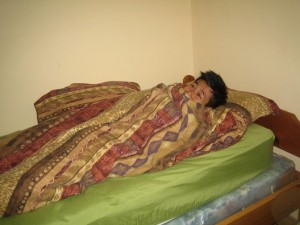Bedsores are also called pressure sores or decubitus ulcers which are painful areas in the body that develops due to excessive pressure on one area. It usually develops on skin covering bony parts of body such as the ankles, heels, hips and tailbone.
https://www.youtube.com/watch?v=LUmIMIXSVRw
People with medical conditions and spends most of the time in a chair or in a bed are susceptible to develop bedsores. People confined in bed usually develop bedsores in the shoulder blades, back or at the side of the head, and the lower back, hip and the tailbone. It can also develop in ankles, heels and the skin at the back of the knees.
Symptoms of bedsores

- Swelling
- Unusual changes in the color and texture of the skin
- Pus-like draining
- The affected area feels cooler or warm to touch
- The wound smells bad which indicate an infection
Stages
- Stage 1 – there is skin discoloration but no open wound. The skin becomes red or blue, purple or white.
- Stage 2 – a shallow open wound and the edges are infected or dead tissue.
- Stage 3 – a wide and open wound. It extends below the top layer of the skin and into the fat tissue layer and fluid or pus drains from the wound.
- Stage 4 – a large wound that affects several layers of tissues of skin. Bone or muscles are exposed and there may be echar which is dark substance which indicates dead tissue or necrotic.
Causes
- Constant pressure placed on any areas of the body will lessen the flow of blood to the tissues which is needed for delivering oxygen and other nutrients to the tissue. Without these nutrients, the damaged tissue will die.
- Friction happens when skin rubs against bedding or clothing especially when the skin is moist.
- Shear happens when two surfaces moves in opposite direction such as when the bed is raised at the head, the body slides down and as the tailbone drives down, the skin above the bone stays in place and pulling in the opposite direction.
Treatment
- Watch for signs of infection such as fever, redness along the border of the ulcer sore, draining pus.
- Clean the wound using warm water and mild soap. Another alternative use a mild-no-wash cleanser in cleaning the affected area.
- Cover the infected area using a prescribed tight gauzed moistened with normal saline. It removes dead skin, and healthy tissue will form and for fast healing of the wound.
- If the sores are infected, use the prescribed systemic antibiotics for fast healing of the infection. Another alternative is using intravenous antibiotics if there is bone infection which usually happens in the pelvic area.
Tips
- Keep turning the body if the person is bedridden at least every two hours. Turn the person from right side to the left and use a pillow to support the body.
- When lying down, avoid elevating the bed more than 30 degrees to avoid sliding and friction on the body.
- Eat a healthy diet to prevent malnutrition and development of bed sores.
Disclaimer / More Information
The material posted on this page on bedsores is for learning purposes only. Learn to recognize and manage this type of wound by taking a first aid and CPR class with one of our training providers.
FACT CHECK
https://www.medicalnewstoday.com/articles/173972.php
https://www.webmd.com/skin-problems-and-treatments/pressure-sores-4-stages#1
https://www.mayoclinic.org/diseases-conditions/bed-sores/symptoms-causes/syc-20355893

